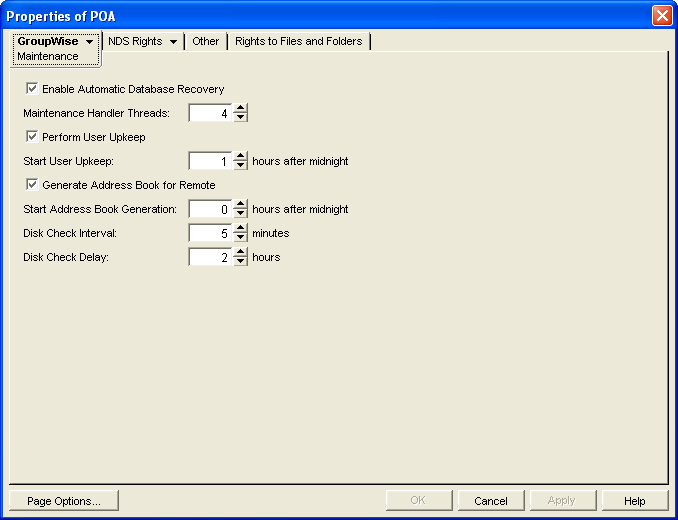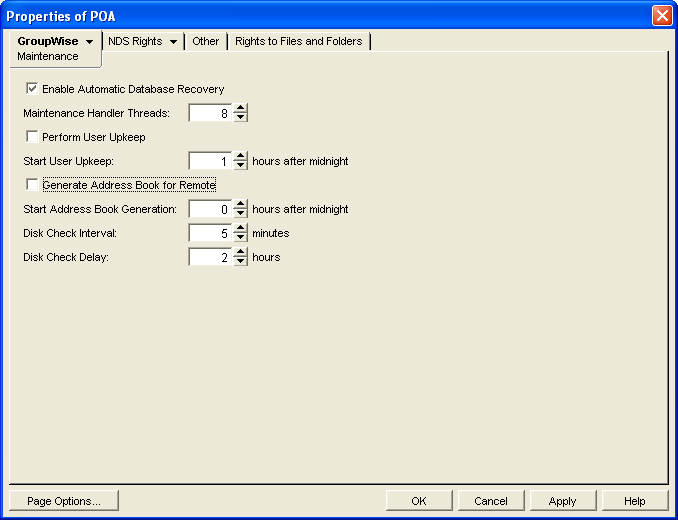38.5 Optimizing Database Maintenance
If you run only one POA for the post office, you can adjust the number of database maintenance threads. If database maintenance needs are extremely heavy for a post office, you can set up a dedicated database maintenance POA to meet those needs.
38.5.1 Adjusting the Number of POA Threads for Database Maintenance
The POA by default performs a certain amount of database maintenance. In addition, you can create your own customized maintenance events as described in Section 36.4.1, Scheduling Database Maintenance and Section 36.4.2, Scheduling Disk Space Management.
By default, the POA starts one thread to handle all POA scheduled events and also all usage of the Mailbox/Library Maintenance feature in ConsoleOne.
To adjust the number of POA database maintenance handler threads:
-
In ConsoleOne, browse to and right-click the POA object, then click .
-
Click to display the Maintenance page.

-
Increase the number in the field.
-
Click to save the new thread setting.
ConsoleOne then notifies the POA to restart so the new setting can be put into effect.
Corresponding Startup Switches You can also use the /gwchkthreads switch in the POA startup file to increase the number of POA threads started for database maintenance activities.
POA Web Console The Status page helps you assess whether the POA is currently meeting the database maintenance needs of the post office. Under the heading, click to display the workload and status of the database maintenance handler threads.
If the POA Web console is password protected as described in Section 37.2.1, Setting Up the POA Web Console, you can change the number of database maintenance handler threads on the Configuration page. Under , click .
38.5.2 Configuring a Dedicated Database Maintenance POA
If a large amount of database maintenance needs to be performed for a post office, you can set up a dedicated database maintenance POA so that the database maintenance activities do not impact other POA activities, such as responding to GroupWise client users.
-
Create a new POA object for the post office as described in Section 36.1.1, Creating a POA Object in eDirectory.
-
Right-click the new POA object, then click .
-
Click to display the Maintenance page.

-
Make sure is selected.
-
Set as needed.
The maximum number of threads you can start for database maintenance is 8.
-
Deselect and deselect . Make sure another POA handles these tasks.
-
Set and as appropriate for the database maintenance events you plan to schedule.
-
Click to save the updated information on the Maintenance page.
-
Click , then create database maintenance events as needed, as described in Section 36.4.1, Scheduling Database Maintenance and Section 36.4.2, Scheduling Disk Space Management.
-
Click .
-
Deselect and set to 0. Make sure another POA handles client/server processing.
-
Click to save the updated information on the Agent Settings page.
-
Click .
-
Deselect . Make sure another POA handles indexing.
-
Click to save the new settings for dedicated database maintenance processing.
-
Install the POA software on a different server from where the original POA for the post office is already running. See
Installing GroupWise Agents
in the GroupWise 8 Installation Guide. -
Add the /name switch to the POA startup file and specify the name designated when you created the new POA object. Also add the /name switch to the startup file for the original POA.
-
For the original POA:
-
Add the ‑‑name switch to the original POA startup file to differentiate it from the new POA you have set up.
-
Deselect for the original POA object.
-
Restart the original POA, so that it no longer performs the database maintenance activities you have set up a dedicated POA to perform.
-
-
Start the dedicated database maintenance POA.